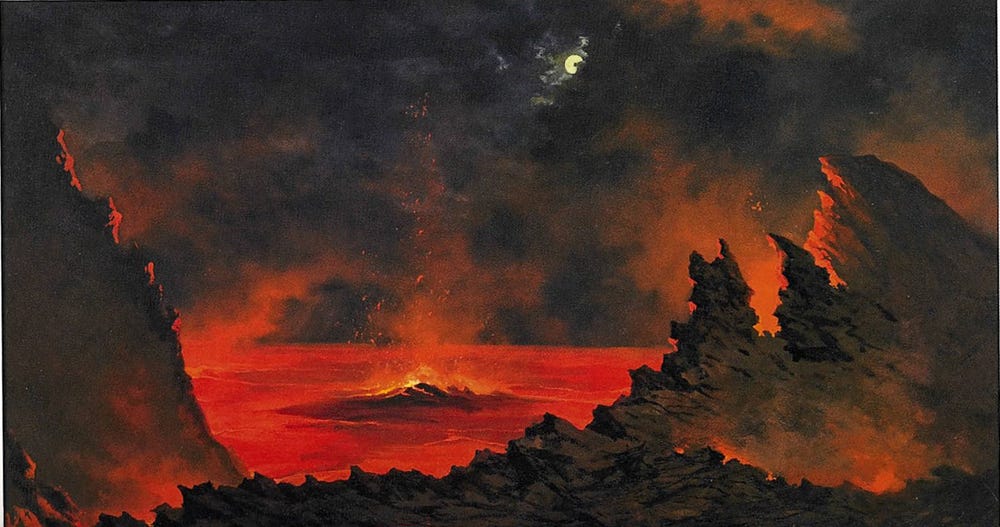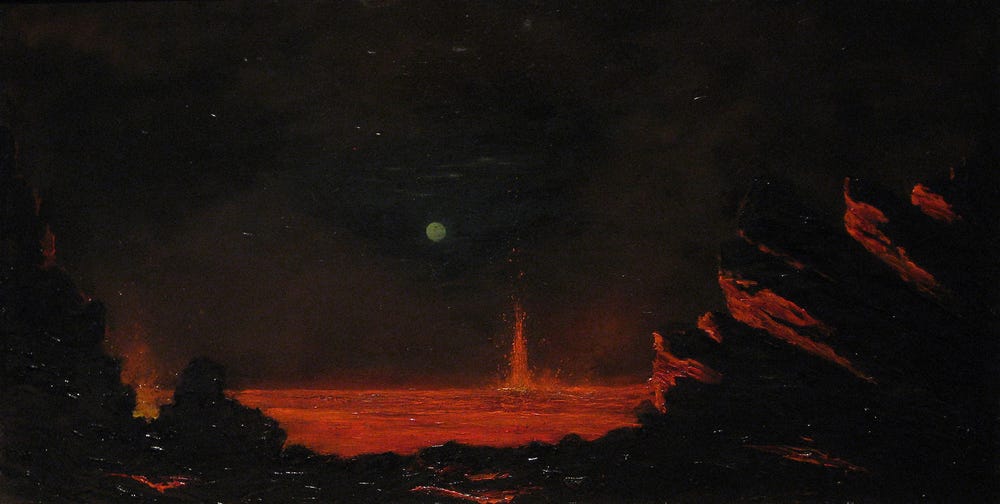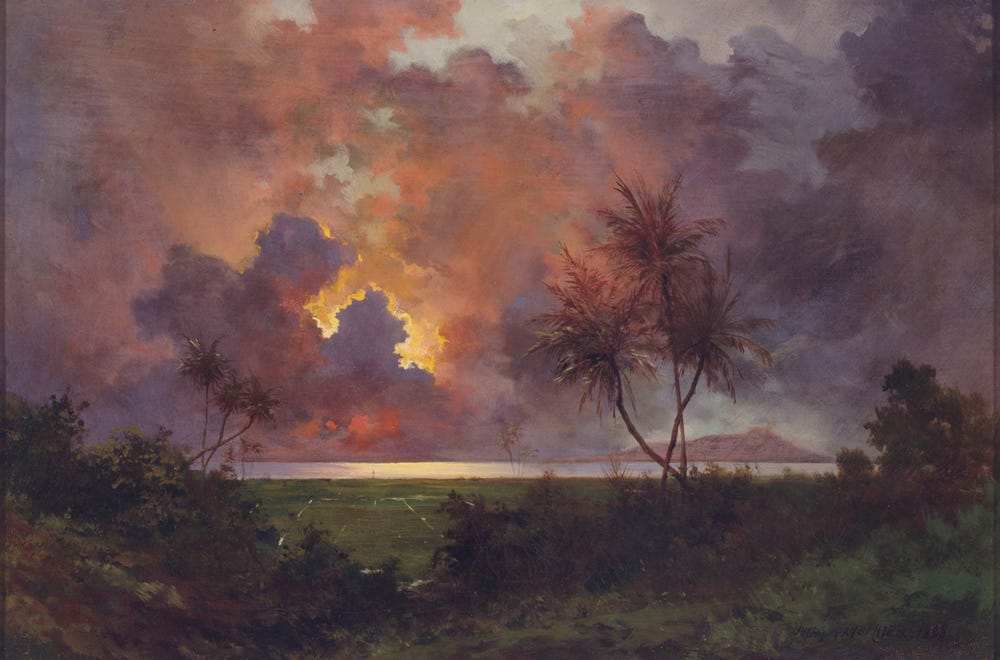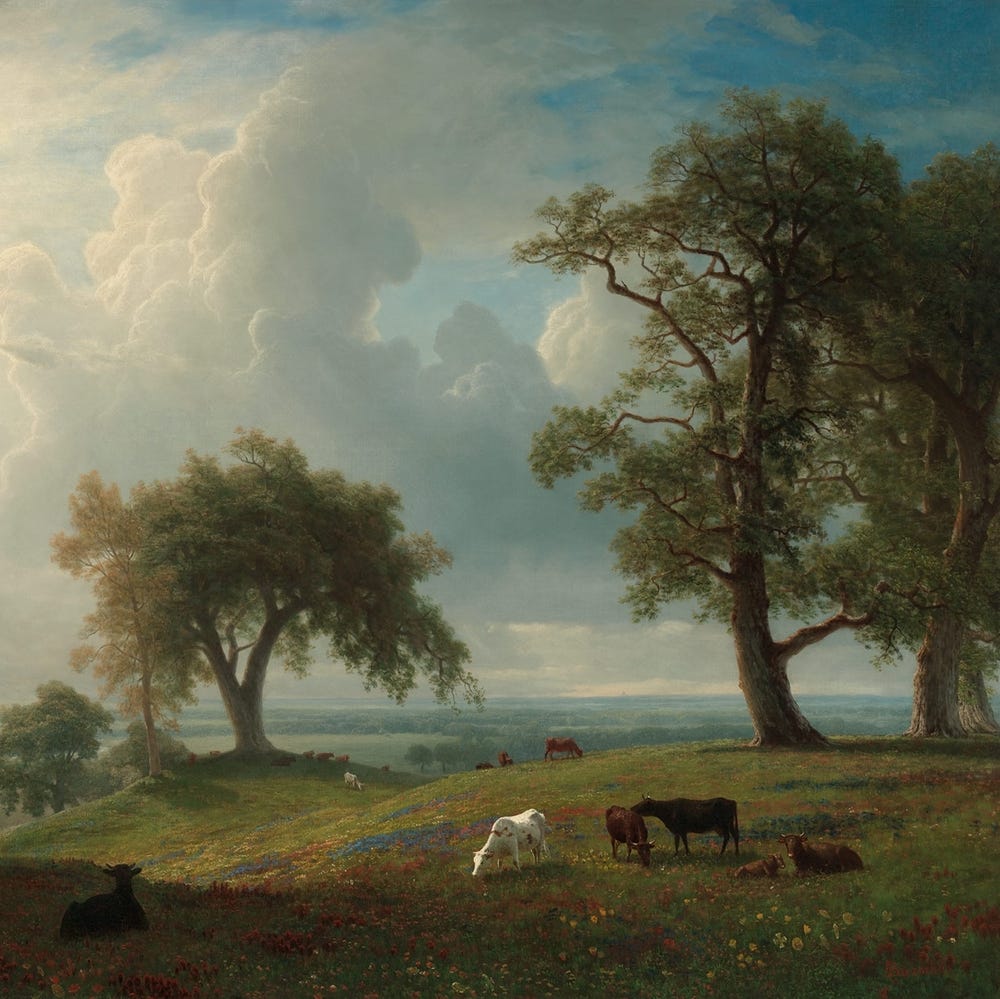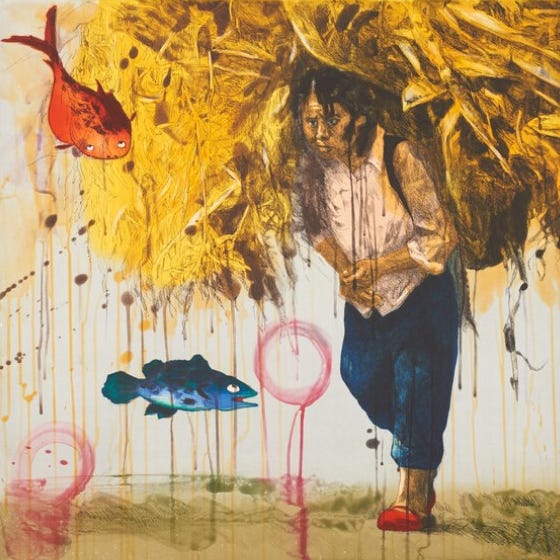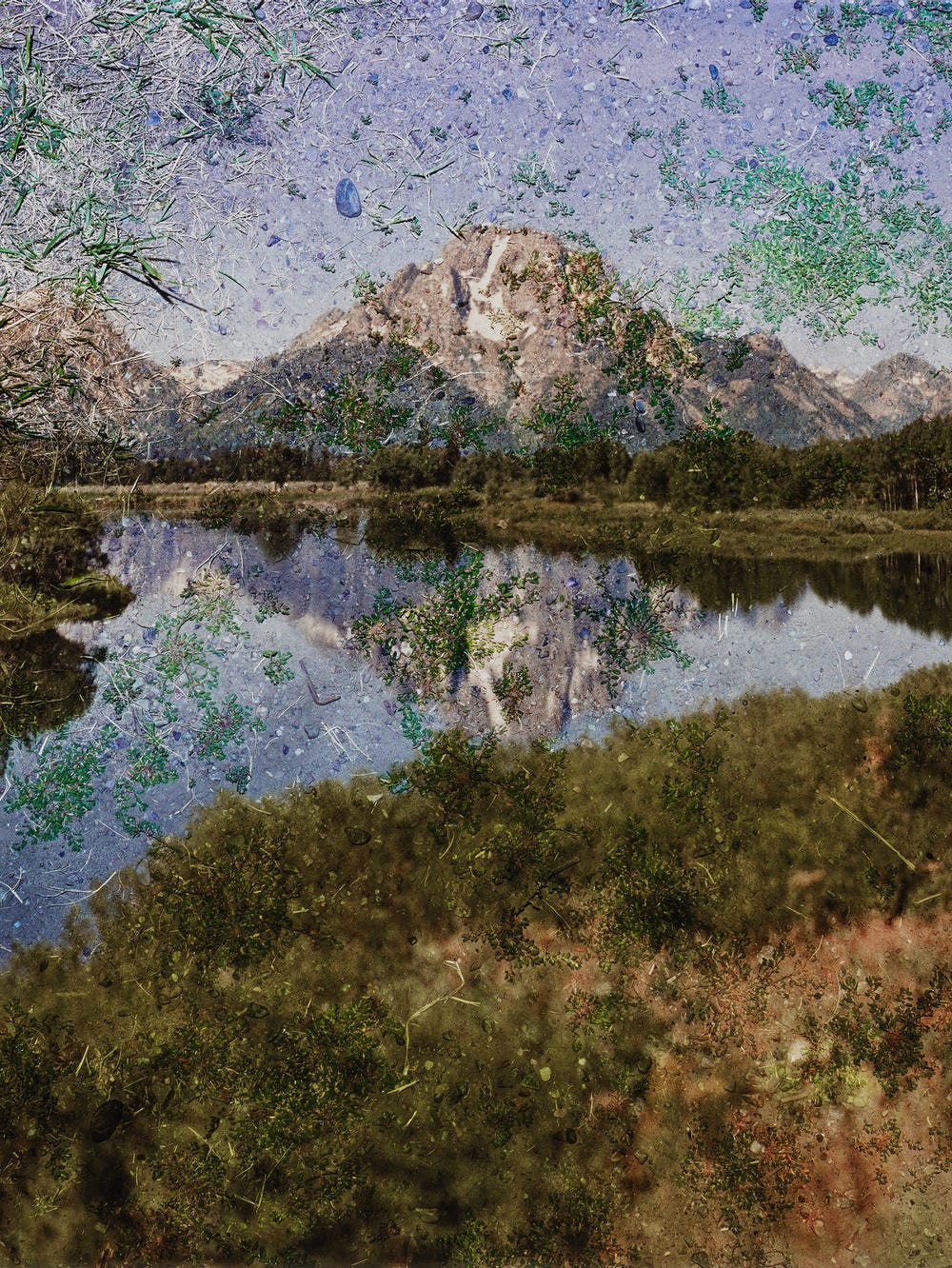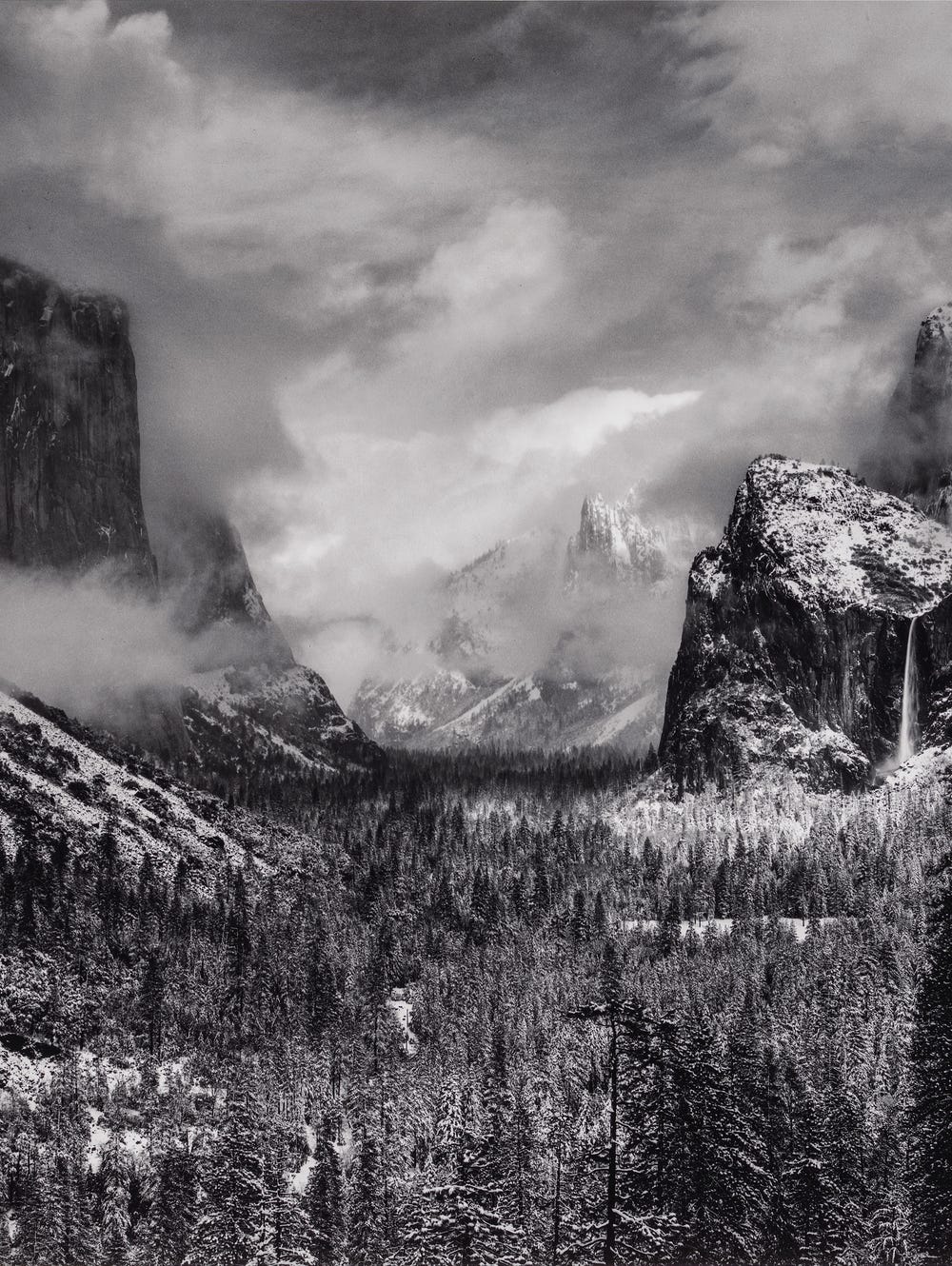Pele, Imperialism, and the Sublime: Tavernier’s Volcano Paintings
By Healoha Johnston
January 20, 2022
Pele, a powerful female deity in Hawaiʻi, embodies the geological elements and related phenomena of volcanic activity. She is not a goddess who directs the lava—she is the lava. Pele has the ability to generate and expand the earth through her eruptions and flows. For these reasons, she is revered as a powerful environmental force capable of changing land formations.
By the time Jules Tavernier (1844–1889) arrived in Hawaiʻi in 1884, depictions of dormant and active volcanoes were already among the most iconic images associated with the Hawaiian Kingdom. Photography made these popular scenes accessible worldwide. In fact, Tavernier’s first paintings of Kīlauea were painted from photographs in his San Francisco studio before he moved to Hawaiʻi. Well-circulated stories of Pele made Tavernier’s paintings all the more intriguing and marketable to island visitors, while the established Hawaiian framework for understanding Pele and volcanism made his work popular among kamaʻāina (native born, literally “land child”).
The volcano image operated on multiple levels and engaged in different social and art-historical discourses: first, as a depiction of Pele’s magnificence and presence; second, as a site of scientific inquiry during a time of colonial imperialism; and third, as an American romantic landscape promoting westward expansion.
Jules Tavernier, The Volcano at Night, ca. 1885–89. Oil on canvas, 19 x 36 in (48.2 x 91.4 cm). Collection of the Honolulu Museum of Art, Gift of Mrs. E. Faxon Bishop, 1959 (2562.1). Image courtesy of Jules Tavernier, Artist & Adventurer by Claudine Chalmers, Scott A. Shields, and Alfred C. Harrison Jr., Pomegranate Communications, Portland, Oregon, 2014 via Wikimedia Commons
Several newspaper publications of the time mention the overwhelmingly enthusiastic response to Tavernier’s paintings. King Kālakaua (reign 1874–1891), members of government, Hawaiʻi’s diverse citizenry, and tourists and diplomats visiting Honolulu were frequent exhibition attendees and patrons of his work. Such range in patronage underscores the multifaceted interpretations artists and viewers brought to bear upon pictures of Hawaiʻi’s land and ocean during a time when Native people in the Pacific were asserting their belief systems and fighting for their right to self-govern as a defense against the violence of European and American imperialism.
Landscape was one of the prevailing genres among representations of Hawai‘i during the 1800s. Early picturesque scenes made their way around the globe through voyaging expedition prints, postcards, and texts written by travel writers with accompanying illustrations. By the mid to late 19th century, Hawaiʻi-born artists such as Joseph Nāwahī (Hawai‘i, 1842–1896) and itinerant artists such as Constance Frederica Gordon-Cummings (Scotland, 1837–1924), James Gay Sawkins (Great Britain, 1806–1878), and Enoch Wood Perry Jr. (United States, 1831–1915) were creating detailed painterly scenes of wahi pana (sacred places), sweeping shorelines, and mountainous ecosystems for an eager audience of local and international collectors.
The drama of Hawai‘i’s volcanic eruptions at Kīlauea and Maunaloa in the 1880s created tremendous interest among tourists and artists around the world. A body of work produced during this time based on the active lava flows became known as the “Volcano School,” of which Tavernier and Charles Furneaux (United States, ca. 1835–1913) were two of the most influential figures. Tavernier’s The Volcano at Night features quintessential attributes of Volcano School paintings. Viewers are positioned at land’s edge, peering into a crater where fiery glows, steaming vents, and heavy clouds are signals of newly erupted molten lava.
Jules Tavernier, Crater of Halemaumau, Kilauea, H. Is., ca. 1887. Oil on canvas, 18.75 x 36.88 in. Gift of Oscar and Trudy Lemer (2003.044). Image courtesy of Monterey Museum of Art
Tavernier established himself as one of Hawaiʻi’s most distinguished landscape painters during his more than four-year stay in the islands, and was best known for his nocturnal volcano paintings. One Hawaiian Gazette critic declared, in response to his painting Halemaumau, “That Monsieur Tavernier has placed a picture before the public that will win him a brilliant reputation wherever exhibited, there is not the slightest doubt, and to prove that the subject is not overdrawn needs but a visit by any critic to the spot where ‘Pele’ loves to dwell.” While we don’t know for certain which piece is referenced in the article, since so many of Tavernier’s paintings were titled after Halemaʻumaʻu circa 1885, the critic goes on to describe a painting similar to the images included here, such as Crater of Halemaumau, Kilauea, H. Is., created in 1887 and now held in the Monterey Museum of Art’s permanent collection.
Jules Tavernier, Sunrise over Diamond Head, 1888. Oil on canvas, 11 3/4 x 17 3/4 in (29.9 x 45.1 cm). Collection of the Honolulu Museum of Art, Gift of Frances Damon Holt in memory of John Dominis Holt, 2001 (9500.1). Image courtesy of the Honolulu Museum of Art
In Sunrise over Diamond Head, 1888, the prominent Waikīkī landmark Lēʻahi, also known as Diamond Head, is painted in a shadowy haze beneath large purple clouds. The ocean’s silvery glow, the stillness of the scene, and the diffused sunbeams hint to the viewer that a storm has recently lifted. Dormant and extinct craters, such as Lēʻahi, were former homes of Pele before she settled at Halemaʻumaʻu, at the summit of Kīlauea, where volcanic eruptions are ongoing.
Like other artists affiliated with the Volcano School, Tavernier’s work exemplifies a fusion of aesthetics: the European sublime and Romantic and American landscape traditions, characterized by scenic depictions of the natural world in turbulence or grandeur. Distinct among landscape styles, painters working with ideas of the sublime often included an element of nature’s potential danger for heightened drama. Many of Tavernier’s late 19th-century Hawaiʻi compositions feature views of smoldering lava pools and shorelines aglow under cloud-laden skies.
Tavernier and other Volcano School painters created work that celebrated the natural wonders of the world. Awe-inspiring natural phenomena rendered with established painterly conventions, such as a shadow-cast moon, gurgling lava, or daylight breaking through storm clouds, implied divinity in nature. These associations, as stunning as they are visually, were linked to notions of manifest destiny and the quest to scientifically document and make claim to perceived uncharted territories. All of this despite the long-standing and continued presence of Indigenous peoples in those places.
Spirituality and the environment are entwined in Hawaiian belief systems. A key difference between the Hawaiian consideration of divinity in nature and manifest destiny is that the relationship between people, gods, and nature in Hawaiian spirituality was not propagated through a racist lens to authorize the decimation of human life and land. In art, expansionist principles have been visualized by painters as daring yet inviting landscape scenes indicating a perilous journey of conquest. These problematic forms of cultural supremacy were established in colonial American landscape art traditions and became painterly formulas by which even Hawaiʻi’s most sacred places were rendered toward the turn of the 20th century.
Text by Healoha Johnston, curator, Asian Pacific American Women’s Cultural History, Smithsonian Asian Pacific American Center
Jules Tavernier and the Elem Pomo is on view at the de Young from December 18, 2021 through April 17, 2022.
Sources Cited
- “Art Notes.” Pacific Commercial Advertiser. April 9, 1887.
- Kame'eleihiwa, Lilikalā.
- Nā Wāhine Kapu: Divine Hawaiian Women
- . Honolulu: ʻAi Pōhaku Press, 1999: 18–39.
- Louis, Renee Pualani and Moana Kahele.
- Kanaka Hawai'i Cartography: Hula, Navigation, and Oratory
- . Corvallis: Oregon State University Press, 2017: 29, 75–84, 161.
- Mead, Ryan. “Surveys, Illustrations and Paintings: Framing Manifest Destiny in the Early American Republic.” Review (Fernand Braudel Center), vol. 35, no. 1 (2012): 31–60.
- Pukui, Mary Kawena, and Samuel H. Elbert. Hawaiian Dictionary: Hawaiian-English, English-Hawaiian. Honolulu: University of Hawaii Press, 1986.
- “Tavernier’s Picture.” Hawaiian Gazette. February 4, 1885.
- Ulukau, Hawaiian Electronic Library, Hawaiian Dictionary.
- “Uncovering America: Manifest Destiny and the West.” National Portrait Gallery.
